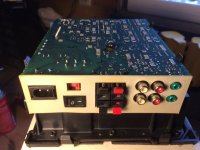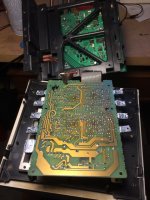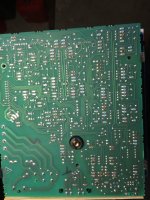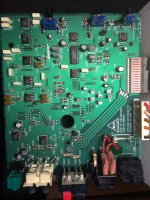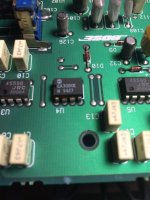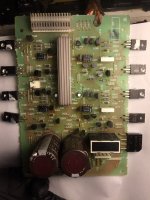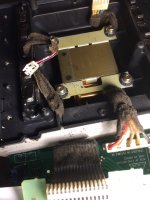This is very helpful - thank you for the follow up.A correction to my post #18: The buzz is on both the left and right satellites, and not on the bass module. When I checked yesterday, I had the right satellite sitting too close to the bass module, and I mis-identified where the sound was coming from. This morning, I held the satellites against my ears. So yes, the 560µF caps and the ±8V regulators are not eliminated as the source of the buzz.
I also was able to verify that the buzz varies with volume setting, so the problem is in the preamp.
I just tested the Lifestyle module. All 3 sets of RCA outs work fine (Fixed, speakers A, speakers B).I have no experience with a Lifestyle module. I don't know if it is possible for you to test them separately, but obviously it would be useful to be able to do so.
As the 1/8" control cable jacks feel a bit wonky on both the Lifestyle & Acoustimass (and show just 2 pins used in the schematic), I dug up a TR cable (vs the TRS cables I was testing). Also tried wiggling it around. No difference.
This morning, the bass module makes no music or distortion. When I turn on the Acoustimass power switch, I just hear a relay click about 0.5 seconds later. At least performance is now consistent.
Unfortunately I don't know what to suggest to get at the problem. I don't see any fuses except on the AC inlet. I haven't even been able to locate on the schematics that relay that we both hear clicking. Perhaps it is part of that thing called "On-Off Control" on page 2.
It is a shame that with the way the boards are tightly stacked and linked with short cables, it is difficult to probe the circuits while powered. The factory must have had cable harnesses so they could power up and test the boards separately. For us, making up such cables would be a lot of work with uncertain rewards.
It is a shame that with the way the boards are tightly stacked and linked with short cables, it is difficult to probe the circuits while powered. The factory must have had cable harnesses so they could power up and test the boards separately. For us, making up such cables would be a lot of work with uncertain rewards.
That's what I thought when looking through the schematics. Graphic looks like the mains voltage selector graphics. Also that is closely tied to the mute on/mute off and pin 12 labeled relay on J2.Unfortunately I don't know what to suggest to get at the problem. I don't see any fuses except on the AC inlet. I haven't even been able to locate on the schematics that relay that we both hear clicking. Perhaps it is part of that thing called "On-Off Control" on page 2.
Going to look now.
That famous relay seems buried under/behind the 1/8" TRS jacks J7 in a small black box.
So I pulled apart the boards to facilitate testing and work. There was some hidden corrosion. So I did some close visual and on-board DMM testing.
- U4 had some brown crust and pins bridged (CA3080E H9427). U103 had some green crust and several bridged pins (& JRC 4559D 3008A).
- Diodes D101, D102, D108, D208 passed voltage both ways.
- Caps C7 & C6 and the bass pot had soldier connections that were "borderline".
- Haven't started to test any caps. . .
** Since the issues are so pervasive (short circuit protection, dynamic bass eq, bass, preamp stage, etc.) I don't think this is repairable.
Thanks to everyone who lent a helping hand; very much appreciated. I have taken some inside photos so hopefully someone finds them useful.
Going forward, we might search for a identical replacement or maybe a Bose passive and connect a newish Rotel 2 channel amp.
So I pulled apart the boards to facilitate testing and work. There was some hidden corrosion. So I did some close visual and on-board DMM testing.
- U4 had some brown crust and pins bridged (CA3080E H9427). U103 had some green crust and several bridged pins (& JRC 4559D 3008A).
- Diodes D101, D102, D108, D208 passed voltage both ways.
- Caps C7 & C6 and the bass pot had soldier connections that were "borderline".
- Haven't started to test any caps. . .
** Since the issues are so pervasive (short circuit protection, dynamic bass eq, bass, preamp stage, etc.) I don't think this is repairable.
Thanks to everyone who lent a helping hand; very much appreciated. I have taken some inside photos so hopefully someone finds them useful.
Going forward, we might search for a identical replacement or maybe a Bose passive and connect a newish Rotel 2 channel amp.
Some Bose photos. . .
Attachments
Opps...the relay we are hearing might be the black Potter & Brumfield (rka 7dt?) next to the big Caps on the amp board.
From the photos, I can't really make out the brown and green crud or the bridged pins you mention on U4 and U103. In the photo showing the foil side of the other board (the bottom board, the one with the heatsinked transformers and the large smoothing caps) I see some brown tones, but that photo is too low resolution to tell what it is. The foil side of the top board (the one with U4, etc.) looks pristine. Generally, this does not look like a unit that has a corrosion issue. In the last photo, looking down towards the transformer, there is lots of brown fuzz that is decrepitated foam that was used to wrap the cables to/from the transformer.
On the diode testing, I am not sure that you can get a reliable reading unless you first lifted at least one lead.
I did notice in the photos showing the heatsinked transistors, that Q308 was canted quite a bit. It leads me to suggest that you gently wiggle (particularly up-down) all those heatsinked transistors to see if they have any looseness; they should feel very stiff, and wiggling them should not result in any movement of their leads where they enter the board. If there is movement there, the solders are broken and need to be reflowed.
One other place to carefully check the solders is on the relay pins, and to reflow them if there is any question about their integrity. The relay (large black box) is obvious in your photo; I am not recalling seeing that on mine, but I did not take photos and I might have missed it. One thing that is definitely different in mine relative to yours is the lack of the TRS jacks, and I am sure this relates to the fact that mine is not an AM3. Given this, my relay is likely different, and smaller.
On the diode testing, I am not sure that you can get a reliable reading unless you first lifted at least one lead.
I did notice in the photos showing the heatsinked transistors, that Q308 was canted quite a bit. It leads me to suggest that you gently wiggle (particularly up-down) all those heatsinked transistors to see if they have any looseness; they should feel very stiff, and wiggling them should not result in any movement of their leads where they enter the board. If there is movement there, the solders are broken and need to be reflowed.
One other place to carefully check the solders is on the relay pins, and to reflow them if there is any question about their integrity. The relay (large black box) is obvious in your photo; I am not recalling seeing that on mine, but I did not take photos and I might have missed it. One thing that is definitely different in mine relative to yours is the lack of the TRS jacks, and I am sure this relates to the fact that mine is not an AM3. Given this, my relay is likely different, and smaller.
Thanks for the comments @NorthPaw. Based on your comments, I will give it a quick clean and touch up some of the soldier joints this morning just for fun. . .
Those are the best macro resolution from our iPhone lol. Funny that the amp board and the back of the eq board are virtually pristine. The top of the eq board had a few green areas and that brown flaky residue; a few of the diode soldier connections were darkened and a few were green.
There is not much more foam to deteriorate from the wires anymore lol.
Those are the best macro resolution from our iPhone lol. Funny that the amp board and the back of the eq board are virtually pristine. The top of the eq board had a few green areas and that brown flaky residue; a few of the diode soldier connections were darkened and a few were green.
There is not much more foam to deteriorate from the wires anymore lol.
This morning I cleaned the corroded parts then touched up the soldier joints. Then touched up all the soldier joints at the cables, jacks, heatsinked transistors, flexible ribbon connectors, input/outputs, relay, higher powered items, etc. Checked the soldier work with a magnifying glass and DMM and cleaned up the flux.
Plugged in and, unfortunately, performance was unchanged so I will throw in the towel. Thanks again
Plugged in and, unfortunately, performance was unchanged so I will throw in the towel. Thanks again
We picked up a used acoustimass passive bass unit and connected it to a nice Rotel 2-channel amp (RB1050?) stuffed away in the basement.
System has bit better bass response (box is bigger) and sounds slightly more hi-fi like; maybe stereo separation is not as good. Overall, I slightly preferred the original system but this was an easy and cheap solution.
System has bit better bass response (box is bigger) and sounds slightly more hi-fi like; maybe stereo separation is not as good. Overall, I slightly preferred the original system but this was an easy and cheap solution.
Thanks for all your support @northpaw.
Some overtime drama.
The expensive optional remote opens some "premium" features on the CD player (random, repeat track, repeat disc) was working intermittently. We opened it up to troubleshoot (the case was just clipped together). The transmitter coil ripped out a soldier pad. So just soldiered that and added some silicone as the ferrite was flapping in the breeze. Works perfectly now.
The optional remote was Japan model RC-11 (614811)
Some overtime drama.
The expensive optional remote opens some "premium" features on the CD player (random, repeat track, repeat disc) was working intermittently. We opened it up to troubleshoot (the case was just clipped together). The transmitter coil ripped out a soldier pad. So just soldiered that and added some silicone as the ferrite was flapping in the breeze. Works perfectly now.
The optional remote was Japan model RC-11 (614811)
- Home
- Amplifiers
- Solid State
- Bose Acoustimass 3 humming
